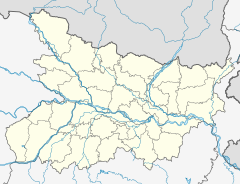Mundeshwari Temple
| Mundeshwari Temple | |
|---|---|

Nagara style architecture of the temple.
|
|
| Name | |
| Other names | Mundeshwari Devi Temple |
| Geography | |
| Coordinates | 24°59′00″N 83°33′53″E / 24.9833958°N 83.5646939°ECoordinates: 24°59′00″N 83°33′53″E / 24.9833958°N 83.5646939°E |
| Country | India |
| State | Bihar |
| District | Kaimur district |
| Location | Kaura |
| Elevation | 608 m (1,995 ft) |
| Culture | |
| Primary deity | Shiva and Shakthi |
| Important festivals | Ramnavami, Shivratri, Navaratra. |
| Architecture | |
| Number of temples | One |
| History and governance | |
| Date built | 105 AD |
The Mundeshwari Devi Temple (also spelled as Mundesvari) is located at Kaura in Kaimur district in the state of Bihar, India on the Mundeshwari Hills. It is an ancient temple dedicated to the worship of Lord Shiva and Shakti and is considered one of the oldest Hindu temples in Bihar. It is also considered as the 'oldest functional' temple of world.
The inscription of an information plaque erected by the Archaeological Survey of India (ASI) at the site indicates the dating of the temple to 108 AD. However, there are other versions for the dating stating the Saka era, prior to Gupta dynasty rule (320 AD) in India, and specifically to 105 AD according to the Administrator of the Bihar Religious Trust Board. The temple, a protected monument under ASI since 1915, is substantially damaged and is under restoration.
The Mundeshwari Devi temple located on the Mundeshwari Hill at an elevation of 608 feet (185 m) is in Kaimur district of Bihar. Located on Kaimur plateau across Son River,(and near Survuwara(suvara) river) there are many archaeological relics on the Mundeshwari Hill.
It can be reached by road via Patna, Gaya, or Varanasi. The nearest railway station is at Mohania - Bhabua Road railway station from where the temple is 22 km by road.
The temple, built of stone, is on an octagonal plan which is rare. It is the earliest specimen of the Nagara style of temple architecture in Bihar. There are doors or windows on four sides and small niches for the reception of statues in the remaining four walls. The temple shikhara or tower has been destroyed. However, a roof has been built, as part of renovation work. The interior walls have niches and bold mouldings which are carved with vase and foliage designs. At the entrance to the temple, the door jambs are seen with carved images of Dvarapalas, Ganga, Yamuna and many other murtis. The main deities in the sanctum sanctorum of the temple are of the Devi Mundeshwari and Chaturmukh (four faced) Shiva linga. There are also two stone vessels of unusual design. Even though the Shiva linga is installed in the centre of the sanctum, the main presiding deity is Devi Mundeshwari deified inside a niche, which is seen with ten hands holding symbols riding a buffalo, attributed to Mahishasuramardini. The temple also has murtis of other popular gods such as Ganesha, Surya and Vishnu. A substantial part of this stone structure has been damaged, and many stone fragments are seen strewn around the temple. However, under the jurisdiction of ASI, it has been the subject of archaeological study for quite some time.
...
Wikipedia

